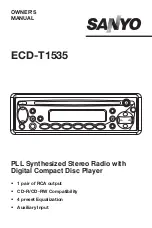
AEQ
TALENT
23
o
Local media port:
this option allows you to configure the value of the IP
port selected to transmit audio at origin over IP. Minimum value 1,024.
Maximum value 65,534. Default values: 5004
o
Adaptive
/
Fixed
and
Adaptive buffer max/Fixed buffer length:
this option
allows you to configure the type and maximum size of reception buffer. See
section 4.4.
o
Symmetric RTP:
this option allows you to force the local unit to send audio
to the same IP and port from which it is receiving audio. The destination
port specified when making the call will be ignored when we receive
packets from the remote equipment. This option will allow you to connect to
equipment with unknown IP and/or port (because it’s behind a router with
NAT, for instance).
Each unit will send audio to the "Local media port" of the remote equipment automatically,
thanks to the SIP signaling protocol. That signaling also accomplishes coding profile negotiation
and call establishment / release from any of both sides of the communication once the remote
equipment has been identified by its IP address and reached.
4.2.3. DIRECT SIP.
This type of connection is selected when you have a connection with SIP protocol in the
signaling phase prior to connection, but without the presence of an external SIP server. It is
necessary to know the IP address of the equipment you want to call in advance, but not
necessarily the destination audio port.
In order to call in Direct SIP mode, you must take into account that for the
URI
or SIP identifier
of the equipment the right syntax is "<unit_name>@<unit_IP_address>" type (for instance,
"
").
When the correspondent
SIP port
is not the 5060 (SIP Standard port) the identifier must include
the used port. For instance: "
[email protected]:5061”
When you create a Call Book, these fields describing a contact can be
modified in the Call Book that can be accessed from a codec individual
control window through the "Contacts" option in "Configuration" (see
section 5.1.7 of "AEQ ControlPHOENIX" user’s manual). In order to call a
same contact using different IP modes (as defined in "INTERFACE" drop-
down menu), different contact entries must be created.
You can access the IP configuration submenu for DIRECT SIP mode by clicking on "
I/F Setup
"
button, and that it is explained in section 6.1.4.2 of "AEQ ControlPHOENIX" user’s manual.
•
In "
SIP Parameters
" submenu you can find:
-
User Name:
enables you to edit the name of the unit and how it will be reflected
in the diverse internal menus of the unit. For a start we recommend you not to
change the configured default User Name, "phtalent_1231" for instance.
-
Display Name:
editable name. This is the public name of the equipment, so
you can recognize the equipment with this identifier externally to the system.
•
You can find the NAT mode selection at "
NAT Traversal
" submenu.
NAT Traversal is a set of tools used by the equipment in order to surpass the NAT
(Network Address Translation) performed by some routers. We can select among
several modes depending on the kind of network the unit is connected to.
Phoenix TALENT offers a total of six different operating modes when traversing
devices with NAT (routers, firewalls…). Each one of those modes is suitable for a
different scenario. For instance, when the units that are establishing communication
are in the same local network, the internal working way will be different than when
it’s done through the Internet.
















































